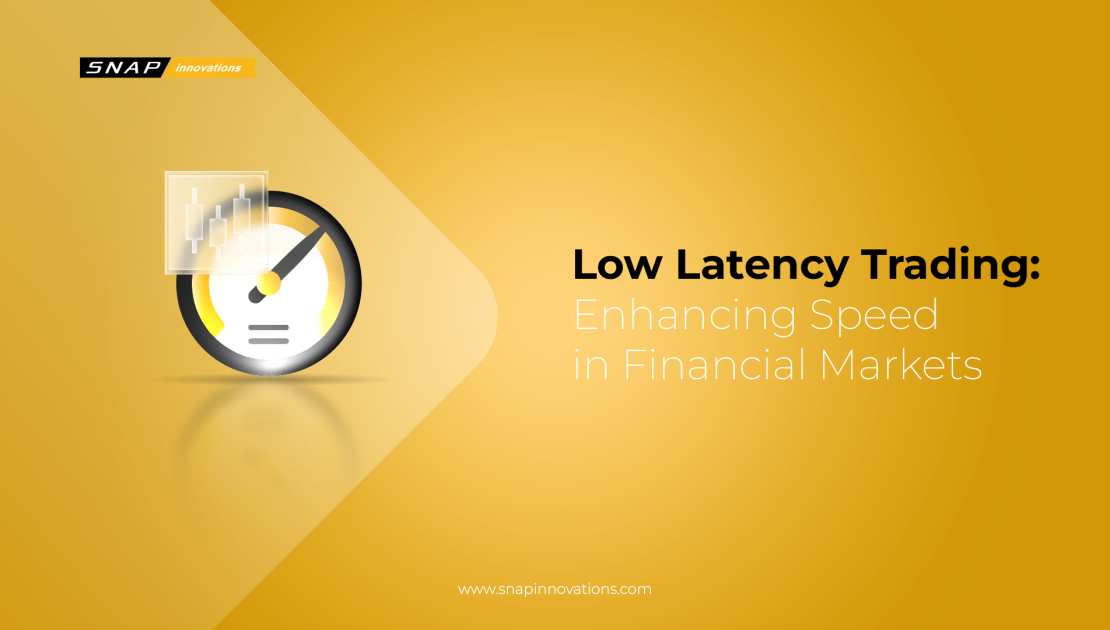In the ever-evolving realm of financial markets, speed is the currency of success. Whether you’re a seasoned institutional investor or an individual trader, the ability to execute orders with lightning speed can make or break your trading endeavors. Enter the world of low latency trading, where every microsecond counts and technology reigns supreme.
In this comprehensive guide, we’ll take you on a journey through the intricacies of low latency trading, shedding light on its fundamentals, strategies, and the profound impact it has on the financial landscape. So, fasten your seatbelts as we embark on a thrilling exploration of how traders and institutions are racing against time in the pursuit of trading excellence.
What is Low Latency Trading?
Low latency trading, often hailed as the pinnacle of trading efficiency, represents a monumental shift in the financial landscape. At its core, it’s the art of shaving precious milliseconds off the time it takes for a trade order to be executed. But beneath this seemingly straightforward definition lies a world of intricate technology, high-stakes competition, and a relentless pursuit of speed. Picture the bustling trading floors of yesteryears, with traders waving their arms and shouting orders.
That was the image of financial markets etched in our minds. But as technology advanced, this image transformed into a whirlwind of digital data, fiber-optic cables, and data centers humming with activity. Low latency trading emerged as a response to this transformation, driven by the realization that in a world where information travels at the speed of light, every fraction of a second matters. It’s not just about executing trades swiftly; it’s about doing so with precision and consistency. It’s about leveraging technology to gain an edge in a landscape where the line between success and failure is often measured in microseconds.
Low latency trading represents the culmination of decades of technological advancements, where traders and financial institutions have harnessed the power of cutting-edge hardware, complex algorithms, and ultra-fast communication networks to gain a competitive edge. It’s a world where microseconds can translate into significant profits or losses, where trading decisions are made in the blink of an eye, and where staying ahead of the competition means staying ahead in the race against time.
The Role of Low Latency Trading
The role of low latency trading in the modern financial landscape is nothing short of transformative. It’s the driving force behind the lightning-fast execution of trades, enabling market participants to capitalize on fleeting opportunities and react to market dynamics in real-time. To understand its role more comprehensively, let’s embark on a journey into the intricate workings of low latency trading and the profound impact it has on various aspects of the financial ecosystem.
Also Read: Trading Events: A Comprehensive Guide to Market Dynamics
At its core, low latency trading is the embodiment of technological prowess in the financial world. It’s the fusion of cutting-edge hardware, high-performance software, and ultra-fast communication networks. Traders and financial institutions invest heavily in infrastructure and technology to minimize the time it takes for trade orders to traverse the vast expanse of the financial markets. This investment is not merely an option; it’s a necessity in a world where competitive advantage hinges on being faster than the competition.
The role of low latency trading extends far beyond mere speed. It’s the backbone of algorithmic trading, a domain where complex algorithms analyze vast datasets and execute orders in microseconds. These algorithms are designed to identify trading opportunities, arbitrage price differences across markets, and manage risk with unmatched precision. The role of low latency trading in algorithmic strategies is akin to the engine in a high-performance sports car; it’s the driving force that propels trading strategies to success.
Strategies for Low Latency Trading Success
 Low latency trading isn’t just about having the fastest technology; it also requires strategic thinking. Traders employ a variety of strategies to maximize their speed advantage. From arbitrage opportunities to market-making and statistical arbitrage, each strategy leverages the power of low latency to gain an edge in the market.
Low latency trading isn’t just about having the fastest technology; it also requires strategic thinking. Traders employ a variety of strategies to maximize their speed advantage. From arbitrage opportunities to market-making and statistical arbitrage, each strategy leverages the power of low latency to gain an edge in the market.
1. Arbitrage Opportunities
At the heart of low latency trading success lies the art of arbitrage. Traders seek price disparities across different markets or exchanges and exploit them for profit. These opportunities exist for only brief moments, requiring lightning-fast execution to capitalize on the price differentials. Common types of arbitrage include spatial arbitrage (exploiting price differences in the same asset on different exchanges) and time arbitrage (profiting from price differences over time).
Successful arbitrageurs invest heavily in cutting-edge technology, co-locating their trading servers in proximity to exchanges’ data centers to minimize network latency. Moreover, they employ sophisticated algorithms that constantly monitor price differentials and execute trades in microseconds. The quest for arbitrage opportunities is a relentless pursuit of speed, precision, and technological innovation.
2. Market Making
Market makers play a pivotal role in maintaining liquidity in financial markets. They continuously provide buy and sell quotes for assets, profiting from the bid-ask spread. In the low latency trading world, market makers use automated algorithms to adjust their quotes rapidly, responding to market fluctuations and order flow. Their success hinges on being faster and more accurate than competitors.
Market makers employ strategies like dynamic pricing, where algorithms assess market conditions and adjust spreads based on volatility and order book depth. They also leverage machine learning to optimize their pricing models and adapt to changing market dynamics. The relentless competition among market makers necessitates constant innovation in algorithmic strategies and technology infrastructure.
3. Statistical Arbitrage
Statistical arbitrage strategies leverage statistical analysis and mathematical models to identify trading opportunities. These models analyze historical data and identify patterns or correlations between different assets. When deviations from these patterns occur, traders execute trades to capitalize on the expected mean reversion. Speed is crucial, as these opportunities can vanish quickly.
Successful statistical arbitrageurs develop complex models that consider a wide range of factors, including market data, economic indicators, and even social media sentiment. They deploy high-performance computing clusters to process vast datasets in real-time, ensuring they can act swiftly when signals emerge.
4. Event-Driven Strategies
Event-driven strategies involve trading based on specific events or news releases. Traders employ algorithms that can process news feeds in real-time, extracting relevant information and making rapid trading decisions. Whether it’s earnings reports, economic indicators, or geopolitical events, event-driven strategies require speed and precision to react swiftly to breaking news.
These algorithms use natural language processing (NLP) and sentiment analysis to gauge the market impact of news events. They must also be well-connected to news sources and data feeds, ensuring they receive information as soon as it becomes available. Successful event-driven traders have robust risk management protocols to protect against sudden market volatility triggered by news events.
5. Algorithmic Pairs Trading
Pairs trading involves simultaneously buying and selling two correlated assets to profit from their relative price movements. In the low latency trading world, algorithms monitor the price relationship between these pairs, executing trades when deviations occur. The ability to identify and act on these deviations quickly is essential for success.
Pairs trading algorithms use statistical methods to assess the historical correlation between assets and identify trading opportunities. They require low-latency access to multiple markets or exchanges to execute trades swiftly. Furthermore, risk management is crucial, as unexpected market movements can lead to losses if positions are not managed effectively.
6. Machine Learning-Based Strategies
Machine learning has ushered in a new era of trading strategies. These algorithms can adapt to changing market conditions and learn from data. Whether it’s predicting price movements, sentiment analysis, or risk management, machine learning-based strategies rely on the speed of dataMandhir processing and execution to gain an edge. Machine learning algorithms use historical data to train predictive models that can forecast market trends.
They continuously update these models as new data becomes available, adapting to changing market conditions. These strategies require substantial computational power and high-speed data access to process information in real-time. Successful machine learning-based traders also focus on robust data quality and feature engineering to enhance the accuracy of their models.
7. Order Flow Analysis
Understanding order flow, the sequence of buy and sell orders in the market, is crucial for low latency traders. Algorithms analyze order book data in real-time to identify imbalances or unusual activity that may signal future price movements. Traders can then execute orders swiftly to take advantage of these insights. Order flow analysis algorithms use various metrics to assess market dynamics, including bid-ask spreads, trade volumes, and order book depth.
They often employ machine learning techniques to detect patterns in order flow data that can inform trading decisions. These strategies require ultra-fast data access and processing capabilities to provide traders with timely insights. Risk management is also a key consideration, as order flow analysis can be sensitive to sudden market changes.
Each of these strategies represents a unique approach to low latency trading, requiring a blend of technology, data analysis, and speed. Success in low latency trading hinges on selecting the right strategy, optimizing algorithms for efficiency, and staying ahead of the competition in the race for speed. As we explore these strategies in detail, you’ll gain a profound understanding of how traders leverage technology to execute their trading plans with precision and agility.
Challenges and Risks in Low Latency Trading
 With great speed comes great responsibility. Low latency trading is not without its challenges and risks. From the relentless quest for even lower latencies to the potential for technology glitches and market instability, traders must navigate a complex landscape. We’ll explore the pitfalls and perils that come with the need for speed.
With great speed comes great responsibility. Low latency trading is not without its challenges and risks. From the relentless quest for even lower latencies to the potential for technology glitches and market instability, traders must navigate a complex landscape. We’ll explore the pitfalls and perils that come with the need for speed.
1. Technology Infrastructure
Building and maintaining a robust technology infrastructure capable of low latency trading is a considerable challenge. Traders must invest in high-performance servers, data centers, and networking equipment. Redundancy and failover systems are essential to ensure uninterrupted trading operations. Moreover, staying at the cutting edge of technology requires continuous upgrades and investments, which can be costly.
Achieving ultra-low latencies demands not only state-of-the-art hardware but also meticulous optimization of software and network configurations. It’s a relentless pursuit of milliseconds, where every component of the technology stack must be finely tuned for peak performance. Furthermore, the arms race in technology means that what is cutting-edge today may become obsolete tomorrow, necessitating a constant cycle of innovation and investment.
2. Regulatory Compliance
Low latency trading operates in a heavily regulated environment. Traders must navigate a complex web of rules and regulations, including market surveillance, trade reporting, and risk management requirements. Staying compliant with evolving regulations can be a resource-intensive task, and non-compliance can result in substantial fines and reputational damage.
Regulatory compliance in low latency trading extends beyond national borders, as global markets demand adherence to international standards. Traders must establish comprehensive compliance programs, including pre-trade risk controls, trade reporting systems, and compliance monitoring tools. Keeping abreast of regulatory changes and ensuring timely adjustments to trading strategies and systems is paramount.
3. Risk Management
The speed of low latency trading can amplify risks. Traders need sophisticated risk management systems to monitor exposure and prevent catastrophic losses. Implementing effective risk controls while still maximizing trading opportunities is a delicate balancing act. Risk management encompasses various facets, including position limits, stop-loss mechanisms, and real-time monitoring of trading activities.
Risk managers must be vigilant in identifying anomalies and deviations from expected behavior, intervening swiftly to mitigate potential losses. The challenge lies in finding the right balance between risk-taking and risk mitigation, as overly conservative risk controls can limit profitability, while inadequate controls can expose the firm to significant financial peril.
4. Competition
The competitive landscape in low latency trading is intense. Traders are constantly vying to be faster and more efficient than their rivals. This competitive pressure can lead to a race for even lower latencies, driving up costs and increasing the risk of technical glitches. Staying ahead in the competition requires not only technological innovation but also strategic differentiation.
Traders seek novel trading strategies, alternative data sources, and unique execution venues to gain an edge. The quest for competitive advantage is a perpetual challenge, as traders must anticipate the moves of their competitors and adapt rapidly to changing market conditions.
5. Data Security
Protecting sensitive trading data is a paramount concern. Traders must safeguard their systems against cyber threats and data breaches. The consequences of a security breach can be severe, including financial losses and damage to reputation. Cybersecurity measures in low latency trading encompass robust firewalls, encryption protocols, and intrusion detection systems.
Furthermore, traders must educate their personnel about cybersecurity best practices to prevent inadvertent security breaches. As cyber threats continually evolve, staying ahead of potential attackers is an ongoing challenge, requiring constant vigilance and adaptation of security measures.
Also Read: AMM vs Order Book: Understanding the Core of Modern Crypto Trading
6. Market Volatility
Low latency trading strategies can be sensitive to market volatility. Rapid price movements can trigger a cascade of orders, leading to unexpected losses. Traders must implement mechanisms to handle extreme market conditions.
Risk management systems must be equipped to recognize abnormal market behavior and adapt trading strategies accordingly. Market volatility can create both opportunities and risks, and traders must navigate this dynamic environment with agility and precision.
7. Liquidity Constraints
In highly liquid markets, executing low latency trades is relatively straightforward. However, in less liquid markets, finding counterparties and executing large orders at low latencies can be challenging. Traders must adapt their strategies to varying liquidity conditions.
This may involve using different order types, optimizing execution algorithms, or even exploring alternative markets with higher liquidity. The ability to effectively navigate liquidity constraints is a crucial skill in low latency trading, as it directly impacts the success of trading strategies.
Each of these challenges and risks adds complexity to the low latency trading landscape. Traders must navigate these obstacles with finesse, employing robust risk management practices and staying attuned to market dynamics and regulatory developments. As we delve into each challenge and risk, you’ll gain a comprehensive understanding of the intricacies of low latency trading.
The Future of Low Latency Trading
 As we stand at the crossroads of financial technology and innovation, the future of low latency trading beckons with promises of even greater speed, efficiency, and sophistication. The journey thus far has been a testament to human ingenuity, as traders and technologists have pushed the boundaries of what’s possible in the pursuit of trading excellence. Yet, the horizon remains ever dynamic, offering both challenges and opportunities that will define the next chapter of low latency trading.
As we stand at the crossroads of financial technology and innovation, the future of low latency trading beckons with promises of even greater speed, efficiency, and sophistication. The journey thus far has been a testament to human ingenuity, as traders and technologists have pushed the boundaries of what’s possible in the pursuit of trading excellence. Yet, the horizon remains ever dynamic, offering both challenges and opportunities that will define the next chapter of low latency trading.
One of the most compelling avenues of the future is the integration of artificial intelligence (AI) and machine learning into low latency trading strategies. These technologies have the potential to revolutionize how trading decisions are made, with algorithms capable of learning and adapting to market conditions in real-time. Machine learning models can analyze vast datasets, identify patterns, and execute trades with a level of sophistication that surpasses traditional rule-based algorithms. The future of low latency trading is one where machines and algorithms work in harmony, harnessing the power of AI to make split-second decisions that optimize trading outcomes.
Conclusion
In conclusion, low latency trading is a fascinating and high-stakes arena where speed is the name of the game. In a world where every millisecond counts, traders and institutions invest heavily in technology, infrastructure, and strategies to gain a competitive edge. While the need for speed is undeniable, it also comes with its share of challenges and risks.
As we look to the future, the evolution of technology promises both opportunities and uncertainties in the world of low latency trading. Whether you’re a seasoned trader or a curious observer, understanding the dynamics of low latency trading is essential in navigating the ever-changing financial markets.


